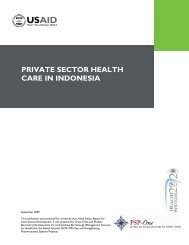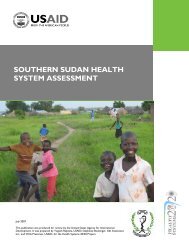An assessment of interactions between global ... - ResearchGate
An assessment of interactions between global ... - ResearchGate
An assessment of interactions between global ... - ResearchGate
Create successful ePaper yourself
Turn your PDF publications into a flip-book with our unique Google optimized e-Paper software.
Health Policy<br />
Panel 1: Global health initiatives with involvement <strong>of</strong> several stakeholders<br />
HIV/AIDS<br />
• Accelerating Access Initiative to HIV Care; African Comprehensive HIV/AIDS<br />
Partnerships; Global Business Coalition on HIV and AIDS; Global Coalition on<br />
Women and AIDS; Global Fund to Fight AIDS, Tuberculosis and Malaria; Global<br />
Media AIDS Initiative; Global Reporting Initiative; HIV Vaccine Trials Network;<br />
HIV/AIDS Treatment Consortium (Clinton Foundation HIV/AIDS Initiative);<br />
Hope for African Children Initiative; Inter-Company for AIDS Drug Development;<br />
International Partnership Against AIDS in Africa; International pharmaceutical<br />
company initiative to support AIDS orphans (Step Forward); Maternal to Child<br />
Transmission; Multi-Country HIV/AIDS Program; President’s Emergency Plan for<br />
AIDS Relief; Safe Injection Global Network; The Corporate Council <strong>of</strong> Africa;<br />
Viramune Donation Program<br />
Malaria<br />
• African Malaria Partnership; <strong>An</strong>timalarial Product Development; Artesunate<br />
Suppository for Emergency Treatment <strong>of</strong> Severe Malaria; European Malaria Vaccine<br />
Initiative; Japanese Pharmaceutical, Ministry <strong>of</strong> Health, WHO Malaria Drug<br />
Partnership; Malarone Donation Program; Medicines for Malaria Venture;<br />
Multilateral Initiative on Malaria; NetMark, a Regional Partnership for malaria<br />
Prevention; Roll Back Malaria; WHO Novartis Coartem<br />
Tuberculosis<br />
• Action TB Program; Eli Lilly Multi-Drug Resistance Tuberculosis Partnership; Partnership<br />
Against Resistant Tuberculosis; Sequela Global Tuberculosis Foundation; Stop TB<br />
partnership (Stop TB); The Global Alliance for TB Drug Development; Tuberculosis<br />
Diagnosis Initiative<br />
Onchocerciasis<br />
• African Program for Onchocerciasis Control; Mectizan Donation Program<br />
Dengue<br />
• Dengue Vaccine Project; Pediatric Dengue Vaccine Initiative<br />
Trachoma<br />
• WHO Alliance for the Global Elimination <strong>of</strong> Trachoma (GET 2020); Lassa Fever<br />
Initiative<br />
Tetanus<br />
• Campaign to Eliminate Maternal and Neo-natal Tetanus<br />
Schistosomiasis<br />
• Praziquantel manufacturing project; Schistosomiasis Control Initiative<br />
Sexually transmitted infections<br />
• Global Microbicide Project; International Partnership for Microbicides<br />
Blindness<br />
• Global initiative to eliminate unnecessary blindness (Vision 2020); International<br />
Trachoma Initiative<br />
Hookworm<br />
• Human Hookworm Vaccine Initiative<br />
Trypanosomiasis and leishmaniasis<br />
• Gates Foundation/University <strong>of</strong> North Carolina Partnership for the Development <strong>of</strong><br />
New Drugs; Sleeping Sickness Initiative; WHO Programme to Eliminate Sleeping<br />
Sickness<br />
(Continues on next page)<br />
specifically for HIV/AIDS and malaria have been effective<br />
in generating rapid responses to these epidemics. By<br />
2007, the Global Fund, PEPFAR, and the World Bank<br />
MAP were contributing more than two-thirds <strong>of</strong> all<br />
external funding to control HIV/AIDS and malaria in<br />
countries with few resources. 5,6<br />
Additional resources on a large scale might have<br />
important effects on public health and health systems in<br />
countries with insufficient resources. GHIs have also<br />
involved new groups <strong>of</strong> people (notably civil society<br />
organisations, leading to an increased focus on social<br />
justice); garnered the political will <strong>of</strong> donors; pioneered<br />
new performance-based approaches; provided support<br />
for interventions that had been thought to be<br />
unsustainable (such as antiretroviral drugs and treatment<br />
for multidrug-resistant tuberculosis); and shown the<br />
capacity to adapt to an operating environment that is<br />
changing. But despite this shift in the ways in which aid<br />
is provided, knowledge <strong>of</strong> the broad effects <strong>of</strong> GHIs on<br />
country health systems is inadequate.<br />
Decades <strong>of</strong> neglect and insufficient investment have<br />
weakened health systems in most developing countries. 7<br />
In the 1980s, economic crises, debt repayment, civil and<br />
political unrest, poor governance, and environmental<br />
pressures exacerbated poverty and inequality, particularly<br />
in Africa. Structural adjustment policies that were<br />
designed to improve the stability <strong>of</strong> fragile economies<br />
led, in many cases, to cuts in public health spending.<br />
Moreover, the <strong>global</strong>isation <strong>of</strong> labour markets, gathering<br />
pace during the 1990s, increased emigration <strong>of</strong> health<br />
workers from the countries that had invested in their<br />
training. The worldwide HIV/AIDS epidemic damaged<br />
health systems that were already overstretched; therefore,<br />
when the worldwide community made a commitment to<br />
the health-related Millennium Development Goals in<br />
September, 2000, 8,9 the health systems in low-income<br />
and middle-income countries were already weak. The<br />
GHIs emerged in the context <strong>of</strong> weakened health<br />
systems. 10<br />
Although new resources, partners, technical capacity,<br />
and political commitment were generally welcomed,<br />
critics soon began to argue that increased efforts to meet<br />
disease-specific targets with selective interventions were<br />
exacerbating the burden on health systems that were<br />
already fragile. 11,12 At the same time, the delivery capacity<br />
<strong>of</strong> GHIs was limited by the weaknesses that were present<br />
in country systems, such as inadequate infrastructure<br />
for service delivery, shortages <strong>of</strong> trained health workers,<br />
interruptions in the procurement and supply <strong>of</strong> health<br />
products, insufficient health information, and poor<br />
governance. 1–3,13,14 The tensions that have been caused<br />
have contributed to a longstanding debate about the<br />
interplay <strong>of</strong> disease-specific programmes or selected<br />
health interventions with integrated health systems.<br />
The difficulties that might be inherent in targeted<br />
approaches to improvement <strong>of</strong> health were recognised as<br />
early as 1951. 15 Since then, much has been written about<br />
2138 www.thelancet.com Vol 373 June 20, 2009
















